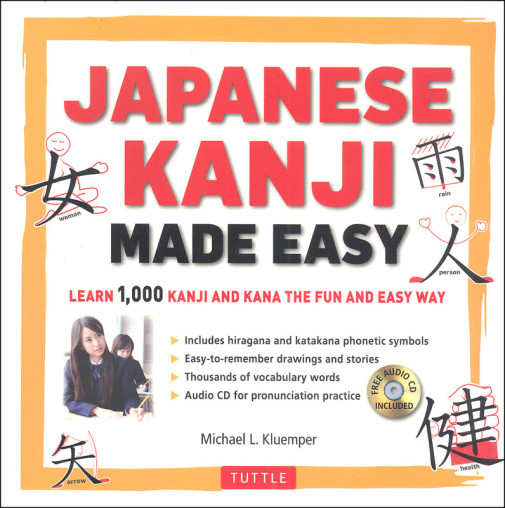We use cookies to make your experience better. To comply with the new e-Privacy directive, we need to ask for your consent to set the cookies. Learn more.
Japanese Kanji Made Easy
Learn 1000 Kanji and thousands more vocabulary words. The Kanji are categories by numbers/colors, persons/body, actions, plants, animals, tools, vehicles, buildings, garments, and even medieval Japan. For each kanji, the text provides an enlarged 1-3" brush stroke version; the English meaning; number of pen strokes; the corresponding entry in the New Nelson Japanese-English Character Dictionary; common pronunciation; and additional vocabulary words. Each kanji includes a story to enhance memory or highlighting the word's development. A helpful background drawing serves as a mnemonic tool. For example, the simple 4-stroke kanji for day includes the shaded image of a sun and the explanation that the character was first a circle with a dot inside. Now the word's written as a window through which we can see each new day. These methods help students remember the kanji and learn the history of the language's development. A few additional pages provide a detailed English/Kanji index and an explanation of the Japanese kana phonetic system. A pronunciation CD is included; digital audio files are available free at the publisher website. 8"x 8," 216 pgs, pb.
Learning the fundamental kanji characters used to write Japanese can be challenging, but this book is designed to speed up learning by presenting the 1,000 most common characters using a mnemonic approach. In a fun and accessible way to learn Japanese, each kanji is associated with memorable visual and verbal clues. For example, the Japanese character for person is superimposed over a sketch of a smiling man. The visual clue is "a person standing on two legs." By seeing the distinctive shape of the kanji, learners create a mental image of its meaning.
Each character is presented as part of a group of characters which share similar traits. These groups use common root symbols known as radicals; they are also categorized by themes such as colors, numbers, animals, or body parts. Pronunciations, meanings and common vocabulary compounds are provided for each character in the group. Mnemonic clues are also given for the basic 92 hiragana and katakana phonetic symbols. A free audio CD helps you learn pronunciation for all of the characters and vocabulary in this book. The introduction explains the basic history and structure of the kanji.
Key feature of this Japanese kanji book include:
- Hiragana and katakana phonetic symbols
- Easy-to-remember drawings and stories for ALL characters
- Thousands of vocabulary words
- Audio CD for pronunciation practice
| Product Format: | Paperback |
|---|---|
| Brand: | Tuttle Publishing |
| Grades: | 4-AD |
| ISBN: | 9784805312773 |
| Length in Inches: | 8 |
| Width in Inches: | 8 |
| Height in Inches: | 0.6875 |
| Weight in Pounds: | 1.25 |

